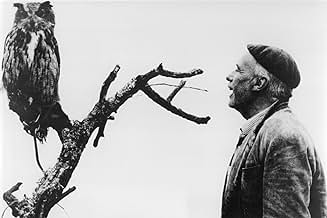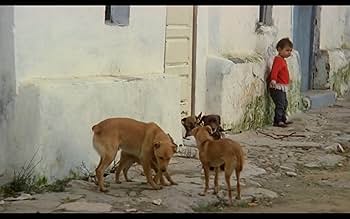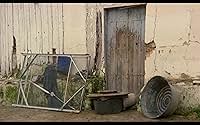ÉVALUATION IMDb
8,1/10
4,9 k
MA NOTE
Ajouter une intrigue dans votre langueSpain, 1960s. The family of poor farmers work hard in the countryside for the rich landowners who exploit them.Spain, 1960s. The family of poor farmers work hard in the countryside for the rich landowners who exploit them.Spain, 1960s. The family of poor farmers work hard in the countryside for the rich landowners who exploit them.
- Prix
- 6 victoires et 4 nominations
Pepín Salvador
- Obispo
- (as José Salvador)
Histoire
Le saviez-vous
- AnecdotesVoted eighth best Spanish film by professionals and critics in 1996 Spanish cinema centenary.
- ConnexionsFeatured in ¡Qué grande es el cine!: Los santos inocentes (1996)
Commentaire en vedette
This the fourth Spanish language film recommended to me as essential viewing by my next-door Spanish neighbours and another excellent choice it is too.
I'm not familiar with the source novel but understand that the setting here is early 60's rural Spain, with the country very much in the Franco dictatorial era which lasted until the mid-70's when democracy and the constitutional monarchy were restored. I'm from the United Kingdom where we probably like every other developed country think we know something of the class struggle but I was staggered at the gap represented here between rich and poor in a recognisably modern context.
We're immediately introduced to the key character of Francisco Rabal's Azarias character, a big unkempt man who although he might be slow mentally nevertheless has an affinity with nature and a particular talent for befriending and petting birds. He also however has no concept of good manners or acceptable behaviour as we easily gauge from his twin habits of defecating in public places and urinating on his hands to stop them, as he says, from chapping. When he loses his position at a wealthy family he joins up with his married sister, her husband and their three children, who are likewise at the lowest end of the social scale.
The family live a life of hardship and drudgery, the husband employed as his selfish draconian, well-to-do master's underling and who has a special skill for beating out game birds for his blood-sport loving boss to shoot by the dozen. His wife helps about the big house, while of their three children, the oldest is keen to escape this life of serfdom and join the army, their middle daughter looks like she will follow her mother into service although there's an inference that she might well be corrupted before she's much older by some rich boor who will treat her as available and willing. Lastly, the couple have a desperately sick younger daughter who is always being carried around and who frequently cries out in pain. At no stage does anyone of the gentry show the slightest concern for this distressed child's obviously ailing health. This miserable family, now plus Azarias, try to eke out a pathetic existence living lives of virtual slavery, their accommodation, you couldn't call it a home, comprising a hovel lit by one bare light bulb. These people resemble nothing so much as Van Gogh's "The Potato Eaters" and yet they are required to accept their lives of grinding poverty as something to thank their monied benefactors.
As for the rich folk, we are permitted some insight into their shallow lives as they periodically arrange or attend grand banquets in the palatial grounds of their grand homes, salve their social consciences by giving their lowly servants the most rudimentary of educations or distributing some low-value coin to them from their position of exaltation. Unsurprisingly, they can also openly indulge in marital affairs, brazenly carrying these on in front of their mute staff witnesses.
It all comes to a head when the peasant husband accidentally falls out of a tree in the course of his duties as a beater, badly breaking his leg in the process. His callous master however has no care or concern for the acute pain the old man is suffering and pushes him to attend a prestigious big hunt he's organising for his fellow-bourgeoisie. Let's just say that while technically speaking the story ends in tragedy, in truth, the conclusion seems altogether almost satisfactory and deserved.
Shot in shades of grey and ochre, in a super-naturalistic style and acted in a hyper-realistic manner by the ensemble cast, its hard not to be reminded of the work of British director Ken Loach who certainly ploughs a similar field. It can't be a coincidence that Azaria bonds with a kite the way the same way the young boy does with his pet kestrel in Loach's "Kes".
It is a slow, arid and at times depressing film. There is some cross-cutting with the timeline by the director which I found slightly confusing at times but the itruth here appears to be that While I understand that the system in rural Spain was widespread well into the 70's, one would like to think that not all master and servant relationships were as stark and brutal as depicted here.
Modern day slavery is unfortunately still happening around the world over as evidenced by stories which occasionally but continually surface on the news. That it seemed to be rife in Spain as late as the 60's is a savage indictment of the status quo in Spanish society.
My eyes were certainly opened by what I saw here. Consider it the disturbing, dark contrast to the French "Manon De Source" and "Jean De Florette" films of around the same time. And remember that the usury witnessed here still went on in Spain only 50 years or so ago.
I'm not familiar with the source novel but understand that the setting here is early 60's rural Spain, with the country very much in the Franco dictatorial era which lasted until the mid-70's when democracy and the constitutional monarchy were restored. I'm from the United Kingdom where we probably like every other developed country think we know something of the class struggle but I was staggered at the gap represented here between rich and poor in a recognisably modern context.
We're immediately introduced to the key character of Francisco Rabal's Azarias character, a big unkempt man who although he might be slow mentally nevertheless has an affinity with nature and a particular talent for befriending and petting birds. He also however has no concept of good manners or acceptable behaviour as we easily gauge from his twin habits of defecating in public places and urinating on his hands to stop them, as he says, from chapping. When he loses his position at a wealthy family he joins up with his married sister, her husband and their three children, who are likewise at the lowest end of the social scale.
The family live a life of hardship and drudgery, the husband employed as his selfish draconian, well-to-do master's underling and who has a special skill for beating out game birds for his blood-sport loving boss to shoot by the dozen. His wife helps about the big house, while of their three children, the oldest is keen to escape this life of serfdom and join the army, their middle daughter looks like she will follow her mother into service although there's an inference that she might well be corrupted before she's much older by some rich boor who will treat her as available and willing. Lastly, the couple have a desperately sick younger daughter who is always being carried around and who frequently cries out in pain. At no stage does anyone of the gentry show the slightest concern for this distressed child's obviously ailing health. This miserable family, now plus Azarias, try to eke out a pathetic existence living lives of virtual slavery, their accommodation, you couldn't call it a home, comprising a hovel lit by one bare light bulb. These people resemble nothing so much as Van Gogh's "The Potato Eaters" and yet they are required to accept their lives of grinding poverty as something to thank their monied benefactors.
As for the rich folk, we are permitted some insight into their shallow lives as they periodically arrange or attend grand banquets in the palatial grounds of their grand homes, salve their social consciences by giving their lowly servants the most rudimentary of educations or distributing some low-value coin to them from their position of exaltation. Unsurprisingly, they can also openly indulge in marital affairs, brazenly carrying these on in front of their mute staff witnesses.
It all comes to a head when the peasant husband accidentally falls out of a tree in the course of his duties as a beater, badly breaking his leg in the process. His callous master however has no care or concern for the acute pain the old man is suffering and pushes him to attend a prestigious big hunt he's organising for his fellow-bourgeoisie. Let's just say that while technically speaking the story ends in tragedy, in truth, the conclusion seems altogether almost satisfactory and deserved.
Shot in shades of grey and ochre, in a super-naturalistic style and acted in a hyper-realistic manner by the ensemble cast, its hard not to be reminded of the work of British director Ken Loach who certainly ploughs a similar field. It can't be a coincidence that Azaria bonds with a kite the way the same way the young boy does with his pet kestrel in Loach's "Kes".
It is a slow, arid and at times depressing film. There is some cross-cutting with the timeline by the director which I found slightly confusing at times but the itruth here appears to be that While I understand that the system in rural Spain was widespread well into the 70's, one would like to think that not all master and servant relationships were as stark and brutal as depicted here.
Modern day slavery is unfortunately still happening around the world over as evidenced by stories which occasionally but continually surface on the news. That it seemed to be rife in Spain as late as the 60's is a savage indictment of the status quo in Spanish society.
My eyes were certainly opened by what I saw here. Consider it the disturbing, dark contrast to the French "Manon De Source" and "Jean De Florette" films of around the same time. And remember that the usury witnessed here still went on in Spain only 50 years or so ago.
- Lejink
- 13 juill. 2021
- Lien permanent
Meilleurs choix
Connectez-vous pour évaluer et surveiller les recommandations personnalisées
- How long is The Holy Innocents?Propulsé par Alexa
Détails
- Date de sortie
- Pays d’origine
- Site officiel
- Langue
- Aussi connu sous le nom de
- The Holy Innocents
- Lieux de tournage
- sociétés de production
- Consultez plus de crédits d'entreprise sur IMDbPro
- Durée1 heure 47 minutes
- Couleur
- Mixage
- Rapport de forme
- 1.66 : 1
- 1.78 : 1
Contribuer à cette page
Suggérer une modification ou ajouter du contenu manquant


![Regarder Tráiler [OV]](https://m.media-amazon.com/images/M/MV5BMDA4ZTRjZjktOTJjYi00MGRlLWE3NDktYzgzNDAyYjk4NjY5XkEyXkFqcGdeQXRyYW5zY29kZS13b3JrZmxvdw@@._V1_QL75_UX500_CR0)




























